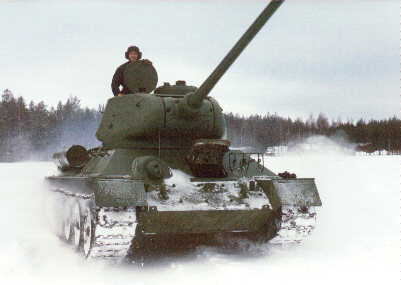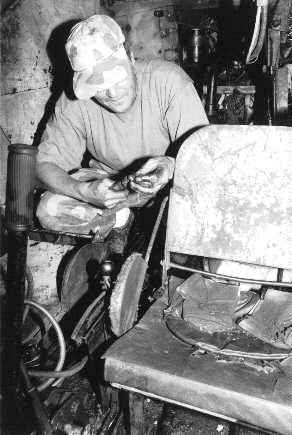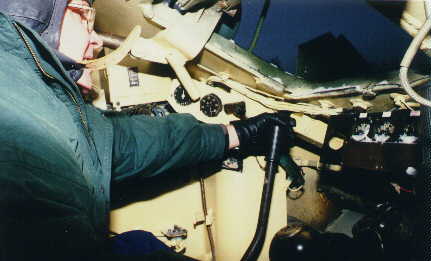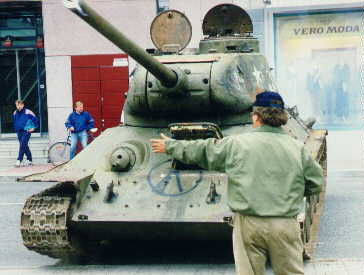04.05.2000: JUST WATCH US ROLL !
 It took a lot of
work but the results speak for themselves. No national insignia has yet been fitted and it
is likely that the tank will be painted many times over if it is given a role in a a film
or two. The insignia will depend on whose colors the vehicle will star in.
It took a lot of
work but the results speak for themselves. No national insignia has yet been fitted and it
is likely that the tank will be painted many times over if it is given a role in a a film
or two. The insignia will depend on whose colors the vehicle will star in.
T-34 Tank:
The Scaup Is At It Again
Part 1/2
Article and photography by J. Hartikka
English edition by Eero Juhola (See home pages: Finnish Weapons)
One of the Continuation War's Soviet tanks rolled into the Eastern Finland town of Joensuu
according to the original plan - though in a somewhat unforeseen way and considerably
behind schedule - in 1994. We went for a test drive in this T-34 tank and after the smoke
quite literally cleared we sat down to write this article.
During the Continuation War the Finns made good use of war-booty Soviet
tanks. The most famous of them, the T-34 was the top of the line at the time; it was
admired or cursed, and distinguished or feared, depending on which side of the large
caliber gun you happened to be sitting. Finnish tankers were justifiably proud of their
own. One of them, in civilian life a sailor on a tug, painted his vessel's name on the
side of the tank: SOTKA (The Pochard or Scaup, i.e. a duck). Soon the name
"Sotka" was used for all captured T-34s and later it was used on the front for
all tanks of this type, including those used by "Ivan", the
not-so-friendly neighbor. So for us too, this is the Scaup.
 Risto Höylä (center) and
Pertti "Cannon"-Korhonen give instructions to Olavi Suokas (inside the tank). A
broken brake lever has to be fixed before the tank can be driven onto the trailer.
Risto Höylä (center) and
Pertti "Cannon"-Korhonen give instructions to Olavi Suokas (inside the tank). A
broken brake lever has to be fixed before the tank can be driven onto the trailer.
This Scaup tank, which found itself at a summer fair in central Joensuu in
1994, is now owned by the Northern Carelia War Veterans' Remembrance Trust and
maintained by the Northern Carelia Weapons History Guild. It arrived in Finland
for the shooting of the German war film Stalingrad, for which it was bought from
the Czechoslovakian Army. And to that country it in turn had arrived as a
"liberator" during the 1968 uprising.
 Is there anyone in there ?
At this point there was no entering the Scaup if you weren't wearing overalls. The inside
of the tower was all covered in soot after the fire. The "Za Stalina" text on
the side of the tower was for the movie Stalingrad.
Is there anyone in there ?
At this point there was no entering the Scaup if you weren't wearing overalls. The inside
of the tower was all covered in soot after the fire. The "Za Stalina" text on
the side of the tower was for the movie Stalingrad.
Strictly speaking this Scaup is the so-called 'heavy T-34'. The additional
weight is mostly due to the modified turret and its longer, larger caliber gun. Arriving
at Joensuu, the Scaup was in weathered Czech paint, the red star and the "Za
Stalina" text having been added for the film. Inside, it was all sooty because a
fire had been lit inside for one of the scenes in the film. The electrical wiring and
equipment had mostly been burnt and the tank had not yet been refurbished into running
order.
 At this point a mere look
at the insides of the partly burnt tank was enough to make you despair ! In the front, the
driver's seat. On the left, one of the steering sticks.
At this point a mere look
at the insides of the partly burnt tank was enough to make you despair ! In the front, the
driver's seat. On the left, one of the steering sticks.
When purchased the tank was intended to be used as a monument. However a
permanent place could not be found and in fact this turned out to be a stroke of luck. The
Trust had a backup plan and this was put into operation - the tank was given into the
daycare of the Weapons History Guild, the members of which were so excited that they spent
countless evenings renovating the tank. Today the Scaup is fully functional, renovated and
painted and resides in a hall near Joensuu. The tank's equipment is mostly functional. She
moves, belches smoke and gives out loud bangs. While waiting for her next role on the
silver screen she performs at various public displays. The Scaup is also paying her old
dues, part of the income she generates goes to a war veterans' fund.
Introducing the T-34
The driver's seat is made of almost comfortable plywood. The vehicle being strictly for
business, a total lack of upholstery is a given. It is possible to crawl into the seat
without undue difficulties, either from the rear by folding the seat's back rest or from
the front, through the driver's hatch. There are basically two ways of going through the
hatch - head or feet first. But the hatch is so small that burly drivers must enter
through the turret.
The massive 38 liter, 500 horsepower V12 diesel engine and its powertrain and fuel tanks
take up most of the room within the tank's body. A cold start of the engine is a most
memorable undertaking in itself. Starting a large diesel with no pre-heating bears little
resemblance to starting a motor car.
 Grab the steering sticks.
During dives into snowbanks snow pours in through the driver's hatch and can be seen on
the dials in this picture, which was taken after rebuilding of the tank.
Grab the steering sticks.
During dives into snowbanks snow pours in through the driver's hatch and can be seen on
the dials in this picture, which was taken after rebuilding of the tank.
Starting the engine requires considerable skill and powers of concentration
from the driver. It requires shamanistic communion with percisely those spirits inhabiting
the engine which, once awakened, will emerge from the exhaust in the form of a cloud of
impressive, blue smoke accompanied by a thunderous roar. That billowing cloud which almost
seems to be alive, like a djinni finally set free after a thousand and one nights
and a hundred and five days.
The starting up ritual begins with a press of a grounding button located at an arm's
length from the driver. Provided the driver is strong enough this button will - with a
genuine Russian 'clunk' sound - connect the tank's 24 volt batteries. As a reward for this
considerable effort, the three dials in front of the driver will come to life. At this
point it is already advisable to thank Providence or the almighty Socialistic spirit of
International Fraternity, depending on one's beliefs. However this is but the first step
in the demanding starting ritual of the T-34.
We will not here go into all the dogma and secrets surrounding the engine starting rites
as this is a subject of considerable complexity and there exist multiple styles and
schools of thought. Let us simply consider the ideal situation where the weather is warm
enough that the engine requires no pre-heating with fuel heater, blow torch or
diesel-soaked, burning rags. Let us also assume that there is enough juice in the
batteries that the engine does not have to be set into motion with - God forbid -
compressed air.
The next step is lubrication. While some people advocate lubricating the driver's innards
with suitable beverages, we're here concerned only with lubricating the engine. The large
diesel engine is equipped with an electrical oil pump which pushes oil into the bearings.
On pressing a switch on the driver's left, the amp dial's needle plummets, accompanied by
a satisfying hum from the pump. At this point the excitement is quite tangible; the moment
of ignition is approaching !
Contact !
The driver slowly pushes the round tip of the gas lever forward. One more sharp intake of
breath. Contemplating past successes, he presses the start button on the interior wall.
Time seems to slow down, then to come to a complete halt. Then something seems to awaken.
It announces its existence with a deep, soulful voice: "chunk, chunk, chunk
chunk-a-chunk chunk puff CHUNK chunk-puff chunk-puff-CHUNK-CHUNK-CHUNK..."
 The sound of the engine becomes more intense as the
massive flywheel slowly gathers revolutions. The occasional puffs of smoke begin to have a
rhythm, the sound is gradually transformed from an intensifying chunking into a steady,
angry growl. The smoke escaping from the mufflers in the rear corners of the hull is thick
enough that - if it were August - someone seeing it in the distance would immediately
summon the fire department to put out a bush fire.
The sound of the engine becomes more intense as the
massive flywheel slowly gathers revolutions. The occasional puffs of smoke begin to have a
rhythm, the sound is gradually transformed from an intensifying chunking into a steady,
angry growl. The smoke escaping from the mufflers in the rear corners of the hull is thick
enough that - if it were August - someone seeing it in the distance would immediately
summon the fire department to put out a bush fire.
 The end of the Scaup's
stroll in Joensuu town center. Now it is time to climb onto the trailer..
The end of the Scaup's
stroll in Joensuu town center. Now it is time to climb onto the trailer..
The driver sits still, listening for any unusual sounds, smelling the air for any unusual
odors, adjusting the idle using the manual gas lever beside his seat. He has his feelers
out for any abnormal vibrations and keeps an eye on the oil pressure and battery charging
gauges. If all is going well, this is the time to send a silent prayer of thanks to the
merciful spirits of nature protecting the Scaup.
The big engine warms slowly, after all there are over sixty liters (almost 16 US gallons)
of motor oil in it. We have to wait and stare at the engine's water and oil temperature
gauges: is the warming up progressing normally ? If it is then our tracked friend will be
ready for a spin when the engine is warm enough.
Driving the Tank
The driver's seat is ingenious in its design - there is no need to adjust it because it is
one of those one-size-fits-all seats; The designers have a complete trust in the driver's
ability to adjust himself so that he fits in the seat. On the other hand the surreal
ascetism of the driver's workplace is enough to make one forget such secondary concerns as
seat comfort. As far a driver vision there is but one concern: How does one see out
of this thing ? The visible sector of the world one sees is narrow enough when the hatch
is open. But close the hatch and that limitation no longer seems too worrysome as
visibility instantly becomes far, far worse ! Luckily one does not have to worry about
driver vision to the sides or towards the rear - there simply isn't any!
 We're succesfully back on
the trailer. The onlookers watch as the smoke clears.
We're succesfully back on
the trailer. The onlookers watch as the smoke clears.
There is no use looking for windshield washer or wipers. If the Scaup had such, the washer
would simply soak his face and the while the wipers might dry his moustache. The vehicle
has no windshield, just the steel hatch which can be closed. The feeling of safety one
gets when thinking about being involved in a road accident while driving this thing is
immense. You would hardly notice a head-on collision with a motor car if you happened to
sneeze when it happened and the hatch were closed. One indication of just what kind of
heavy-duty use the hatch is meant for is the spring which holds it open - it is about the
same size as those used in the suspensions of ordinary delivery vans...
The clutch, brake and gas pedals occupy their familiar places, just like in any car, and
they are certainly within one's reach, being so very high and close to the driver. The
driver's knees do not interfere with turning the steering wheel because there is no
steering wheel. Instead, the tank is driven using two steering or brake sticks which
project upwards and towards the front, flanking the driver on both sides.
A pull of the stick and the ingeniously constructed, eccentrically lightened mechanism
first disengages the track's clutch, preventing engine power from driving it. Pulling the
stick further back will brake the track, tightening the turn. The brake pedal brakes both
tracks simultaneously but it is rarely needed and, compared to the steering sticks, it is
not too efficient either.
More: Part 2/2 >>
Links Gunwriters Part 2/2
>>
Gunwriters on the Web T-34 Tank,
part 1: http://guns.connect.fi/gow/T34tank1.html